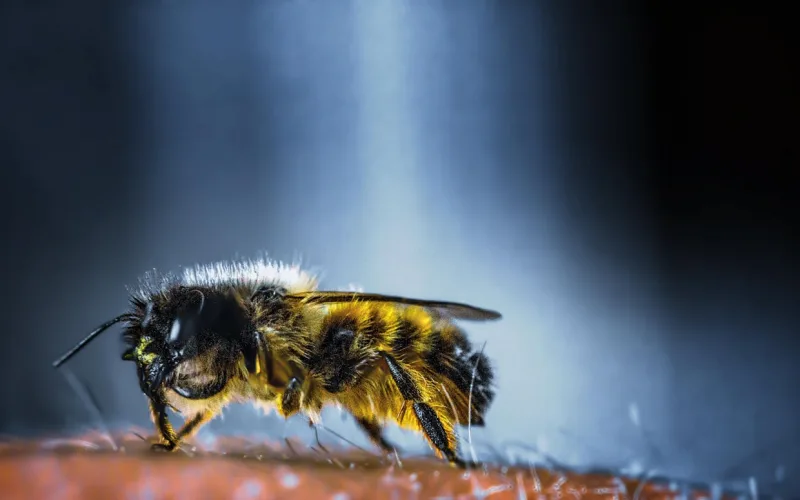Last Updated on June 27, 2025 by Ecologica Life
Float like a butterfly, sniff out cancer like a bee.
A new study decided to explore honeybees’ excellent sense of smell to discover if they could detect lung cancer. It turns out that honeybees can detect the subtle odours of lung cancer in the lab. The faint odour of a disease can even be detected on a patient’s breath. In this article, we will explore the science behind this discovery and its implications.
Table of Contents
The Science Behind the Discovery
Background on Bees’ Sensory Abilities
Honeybees are renowned for their extraordinary sense of smell, which allows them to detect and differentiate a wide variety of odours at incredibly low concentrations. This ability is vital for their survival, helping them to locate flowers, communicate with other bees, and navigate their environment.
Human breath contains biomarkers (odorants) that can be targeted for early disease detection. The bee’s olfactory system, primarily housed in its antennae, is so sensitive that it can detect odorant molecules in concentrations as low as parts-per-billion to parts-per-trillion. This precision has sparked interest in the scientific community, leading to research into how bees’ olfactory abilities can be used to detect specific compounds associated with human diseases, such as lung cancer.
The Experiment
In a groundbreaking study, researchers explored the potential of using honeybee olfactory neuronal circuitry to detect biomarkers in human breath. Human breath contains volatile organic compounds (VOCs), which serve as biomarkers for various diseases, including lung cancer.
Scientists hooked the brains of living bees to electrodes and passed different scents under their antennae and recorded their brain signals.
“It’s very clear — like day and night — whether [a bee] is responding to a chemical signal or not”
Dabajit Saha, a neural engineer at Michigan State University in East Lansing.
The honeybees were held in place with 3D-printed plastic harnesses and some wax while the researchers performed bee brain surgery, attaching wires to the region that processes odours. A device then delivered puffs of air to the insects’ antennae.
Each puff could contain a mixture of mingling odours, such as those exhaled by healthy people. Another mixture mimicked the breath of lung cancer patients, which contain distinct odours that human noses can’t detect. Using electrical signals read from the bees’ brains, the researchers were able to distinguish between the two types of synthetic breath at least 93% of the time.
In a separate experiment, Saha’s team collected air lingering above lung cells grown in the lab. The bees could successfully tell the difference between air samples taken near healthy cells and those gathered near cells of two cancer types: small-cell lung cancer and non-small-cell lung cancer.
Saha’s team hopes to use their bee olfactory sensor to test the breath of actual cancer patients. The device’s biggest weakness, he says, is that is lasts just a few hours before the bees’ brain health wanes and the responses become unstable. But it works fast and spits out results in real-time. With just one bee brain, Saha says, his team could theoretically test more than 100 samples.
Implications for Medical Diagnostics
Lung cancer is one of the deadliest forms of cancer worldwide, largely due to the difficulty of detecting it in its early stages (this is partly because lung cancer was until recently one of the least funded and therefore least researched forms of cancers). Current diagnostic methods, such as low-dose CT scans and tissue biopsies, are effective but come with several limitations. These procedures can be invasive, expensive, and are often only employed after symptoms have appeared, which may be too late for effective treatment.
The discovery that honeybees can detect lung cancer biomarkers through their olfactory system represents a revolutionary approach to lung cancer diagnostics. Unlike existing methods, which rely on imaging or invasive sampling, bee-based detection offers a non-invasive alternative that could be performed at a much earlier stage. This method could lead to more timely interventions, significantly improving patient outcomes.
Challenges and Considerations
While the potential benefits of bee-based diagnostics are significant, integrating this method into mainstream medical practice comes with challenges. A key concern is scalability — how can we reliably manage bees on a large scale to consistently detect lung cancer? Developing standardised protocols and ensuring consistent results across different settings will require careful planning. Additionally, we must consider the ethical implications of using living creatures in medical diagnostics, including the impact on bee populations and the responsibility to care for these vital insects.
Ideally, we could learn how the bees do it and develop machines that can mimic their olfactory capabilities. Unfortunately, we don’t have anything with that kind of resolution yet.
Bees and Forever Chemicals
Other experiments by Saha’s team also showed that bees’ olfactory capabilities extends to other trace odours, such as those emitted by perfluoroalkyl and polyfluoroalkyl substances, commonly known as PFAS, or forever chemicals. “That actually blew my mind,” he says. “PFAS in the environment are very, very hard to detect.”
What are PFAS?
PFAS are a group of synthetic chemicals that have been used in a wide range of industrial applications and consumer products since the 1940s. They are commonly found in non-stick cookware, water-repellent clothing, stain-resistant fabrics and carpets, firefighting foams, and many other products that resist grease, water, and oil. While their durability makes them useful in these applications, it also means that they do not break down easily, leading to widespread environmental contamination.
Over the years, PFAS have been detected in water supplies, soil, air, and even in the blood of humans and animals. This widespread contamination is concerning because exposure to certain PFAS has been linked to adverse health effects including cancer, liver damage, immune system dysfunction, and developmental issues in children.
A Guide to Forever Chemicals (PFAS).
The Implications

This further finding by Saha’s team is significant because it opens up new possibilities for environmental monitoring and public health protection. Traditional methods for detecting PFAS in the environment often require sophisticated and expensive equipment and time-consuming procedures. In contrast, using honeybees as biological sensors could provide a more efficient, cost-effective, and potentially portable method of detecting these hazardous substances in real-time.
Of course, the ethical issues mentioned above also apply here; we want to make sure that we don’t negatively impact this vital species any more than we already have. We must ensure that our efforts to protect the environment extend to caring for these vital insects and their populations, and aim to be environmentally responsible on all fronts, not just one.
Bumblebees fail Colour Vision Test Due to Common Pesticide.
Bottom line
Once again, nature is proving itself to be very clever. Nature provides what we can only poorly imitate artificially. This discovery is yet another reminder of the need to work in harmony with nature, using our intelligence to understand and harness its capabilities.
Lung cancer remains one of the deadliest forms of cancer due to the lack of ability to detect it. Bees have provided us a clue as to how this can be done. Now, if we can just work out how to scale up this non-invasive technique, we could potentially use it to detect a whole range of diseases and even environmental pollutants.








